The NVIDIA GeForce GTX 980 Review: Maxwell Mark 2
by Ryan Smith on September 18, 2014 10:30 PM ESTCompany of Heroes 2
Our second benchmark in our benchmark suite is Relic Games’ Company of Heroes 2, the developer’s World War II Eastern Front themed RTS. For Company of Heroes 2 Relic was kind enough to put together a very strenuous built-in benchmark that was captured from one of the most demanding, snow-bound maps in the game, giving us a great look at CoH2’s performance at its worst. Consequently if a card can do well here then it should have no trouble throughout the rest of the game.
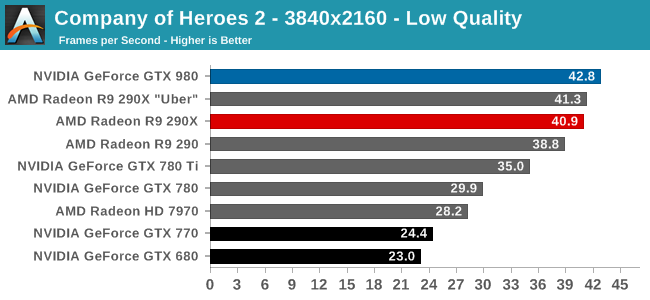

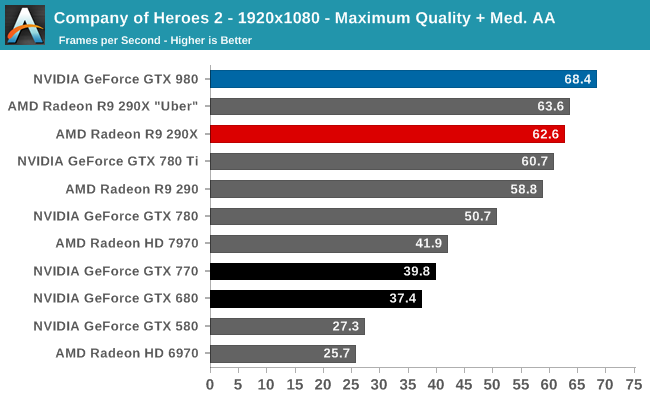
Since CoH2 is not AFR compatible, the best performance you’re going to get out of it is whatever you can get out of a single GPU. In which case the GTX 980 is the fastest card out there for this game. AMD’s R9 290XU does hold up well though; the GTX 980 may have a lead, but AMD is never more than a few percent behind at 4K and 1440p. The lead over the GTX 780 Ti is much more substantial on the other hand at 13% to 22%. So NVIDIA has finally taken this game back from AMD, as it were.
Elsewhere against the GTX 680 this is another very good performance for the GTX 980, with a performance advantage over 80%.
On an absolute basis, at these settings you’re looking at an average framerate in the 40s, which for an RTS will be a solid performance.
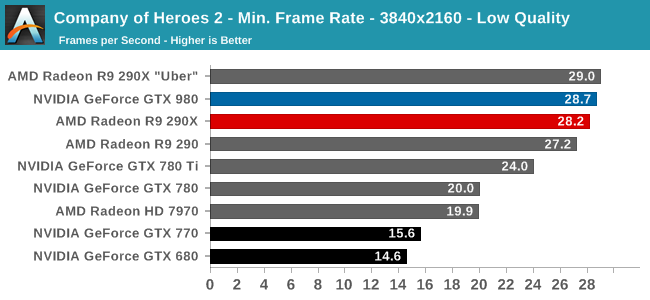
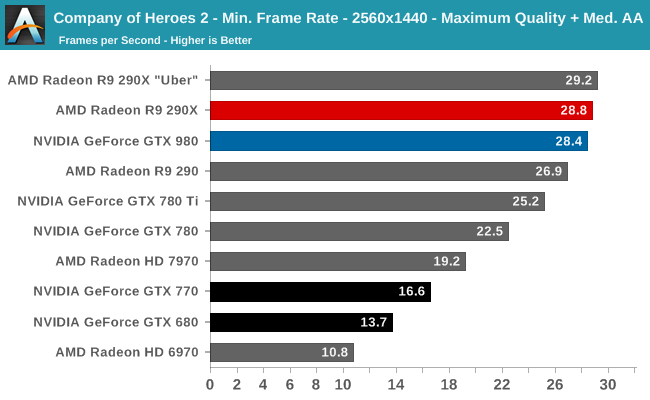
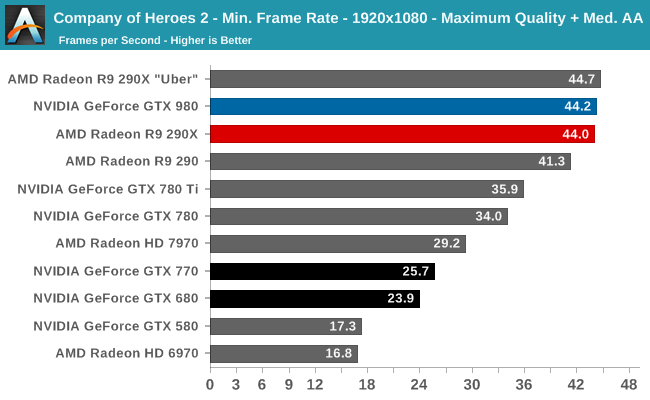
However when it comes to minimum framerates, GTX 980 can’t quite stay on top. In every case it is ever so slightly edged out by the R9 290XU by a fraction of a frame per second. AMD seems to weather the hardest drops in framerates just a bit better than NVIDIA does. Though neither card can quite hold the line at 30fps at 1440p and 4K.










274 Comments
View All Comments
atlantico - Friday, September 19, 2014 - link
I'm sorry, but I couldn't care less about power efficiency on an enthusiast GPU unit. The 780Ti was a 250W card and that is a great card because it performs well. It delivers results.I have a desktop computer, a full ATX tower. Not a laptop. PSUs are cheap enough, it's even a question of that.
So please, stuff the power requirements of this GTX980. The fact is if it sucked 250W and was more powerful, then it would have been a better card.
A5 - Friday, September 19, 2014 - link
They'll be more than happy to sell you a $1000 GM210 Titan Black Ultra GTX, I'm sure.Fact is that enthusiast cards aren't really where they make their money anymore, and they're orienting their R&D accordingly.
Fallen Kell - Friday, September 19, 2014 - link
Exactly. Not only that, the "real" money is in getting the cards in OEM systems which sell hundreds of thousands of units. And those are very power and cooling specific.Antronman - Sunday, September 21, 2014 - link
Yep, yep, and yep again.For OEMs, the difference between spending 10 more or less dollars is huge.
More efficient cards means less power from the PSU. It's one of the reasons why GeForce cards are so much more popular in OEM systems.
I have to disagree with the statement about enthusiast cards not being of value to Nvidia.
Many people are of the opinion that Nvidia has always had better performance than AMD/ATI.
Tikcus9666 - Friday, September 19, 2014 - link
For desktop cards power consumption is meaningless to the 99%Price/Performance is much more important. if Card A uses 50w more under full load than card B, but performs around the same and is £50 cheaper to buy at 15 p per kwh cost for energy it would take 6666 hours of running to get your £50 back. Add to this if Card A produces more heat into the room, in winter months your heating system will use less energy, meanning it takes even longer to get your cash back.... tldr Wattage is only important in laptops and tablets and things that need batterys to run
jwcalla - Friday, September 19, 2014 - link
At least in this case it appears the power efficiency allows for a decent overclock. So you can get more performance and heat up your room at the same time.Of course I'm sure they're leaving some performance on the table for a refresh next year. Pascal is still a long way's off so they have to extend Maxwell's lifespan. Same deal as with Fermi and Kepler.
Icehawk - Friday, September 19, 2014 - link
When I built my mATX current box one criteria was that it be silent, or nearly so while still being a full power rig (i7 OC'd & 670), and the limitation really is GPU draw - thankfully NVs had dropped by the 6xx series enough I was able to use a fanless PSU and get my machine dead silent. I am glad I don't need a tower box that sounds like a jet anymore :)I would love to see them offer a high TDP, better cooled, option though for the uber users who won't care about costs, heat, sound and are just looking for the max performance to drive those 4k/surround setups.
Yojimbo - Friday, September 19, 2014 - link
I agree that power consumption in itself isn't so important to most consumer desktop users, as long as they don't require extra purchases to accommodate the cards. But since power consumption and noise seem to be directly related for GPUs, power efficiency is actually an important consideration for a fair number of consumer desktop users.RaistlinZ - Sunday, September 21, 2014 - link
Yeah, but they're still limited by the 250W spec. So the only way to give us more and more powerful GPU's while staying within 250W is to increase efficiency.kallogan - Friday, September 19, 2014 - link
dat beast